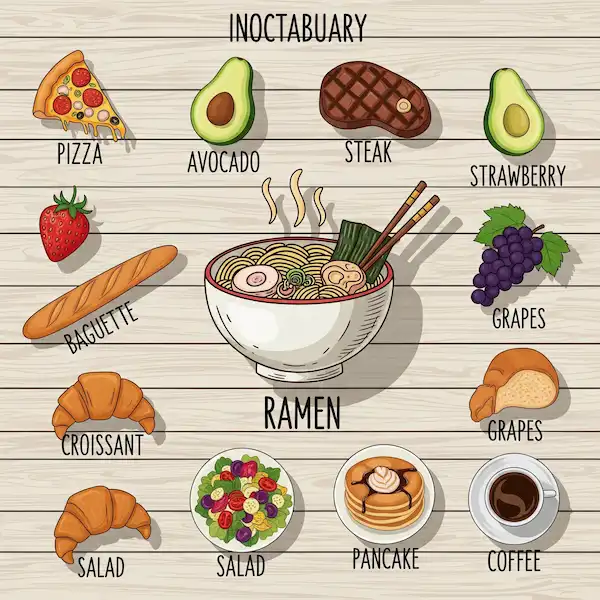Food Glorious Food: A Food Vocabulary Guide for Foodies
Welcome to the delicious world of food vocabulary! Whether you love cooking, eating, or just talking about your favorite dishes, having the right words to describe food is essential. This guide is perfect for intermediate English learners who want to expand their foodie vocabulary. Let’s get started!
Describing Flavors
One of the most exciting parts of food is its flavor! Here are some common food vocabulary words to describe tastes:
| Word | Meaning | Example |
| Sweet | Having a sugary taste | This cake is very sweet. |
| Sour | Having a sharp, acidic taste | Lemons have a sour taste. |
| Salty | Containing salt | The soup needs a little more salty flavor. |
| Bitter | Having a sharp, often unpleasant taste | Dark chocolate can taste slightly bitter. |
| Umami | Savory, meaty, or brothy taste | Soy sauce has a rich umami flavor. |
| Spicy | Producing a burning sensation in the mouth | This curry is very spicy! Be careful! |
| Tangy | Sharp and slightly sour | The salad dressing is nice and tangy. |
| Bland | Lacking flavor | This chicken soup tastes a little bland. |
| Rich | Having a strong, often fatty or creamy flavor | The chocolate mousse was incredibly rich. |
| Mild | Gentle and not strong in flavor | This cheese has a very mild flavor. |
Tip: Try to use these words when you eat! Pay attention to the different flavors in your food and describe them in English.
Describing Texture
The way food feels in your mouth is also important. Here are some food vocabulary words to describe texture:
| Word | Meaning | Example |
| Crunchy | Making a sharp noise when you bite it | These potato chips are so crunchy. |
| Crispy | Firm and making a slight crackling sound | The fried chicken has a lovely crispy skin. |
| Chewy | Needing to be chewed for a long time | This caramel is very chewy. |
| Soft | Easy to bite and not firm | The bread is wonderfully soft and fresh. |
| Tender | Easy to cut or chew; not tough | The steak was cooked until it was very tender. |
| Smooth | Having an even, lump-free texture | The smoothie is so smooth and creamy. |
| Creamy | Rich, smooth, and like cream | The ice cream has a delicious creamy texture. |
| Gooey | Soft, sticky, and slightly runny | The melted cheese on the pizza was gooey. |
| Firm | Solid and not soft | This tofu has a nice firm texture. |
| Runny | Liquid and flowing easily | The egg yolk was perfectly runny. |
Additional Help: Sometimes, two words can be combined to describe texture, like “crispy on the outside and chewy on the inside.”
Cooking Methods
Knowing how food is cooked can also help you understand and describe it better:
| Method | Description | Example |
| Boiled | Cooked in hot water | I had boiled eggs for breakfast. |
| Fried | Cooked in hot oil or fat | These fried noodles are delicious. |
| Grilled | Cooked over direct heat, often with lines | We’re having grilled fish for dinner. |
| Roasted | Cooked in the oven with dry heat | The roasted vegetables are very flavorful. |
| Baked | Cooked in the oven, usually for breads and cakes | She baked a delicious chocolate cake. |
| Steamed | Cooked using steam | Steamed rice is a common side dish. |
| Stir-fried | Cooked quickly in a hot pan with a little oil | He stir-fried some vegetables and tofu. |
| Simmered | Cooked gently at a low boil | The soup has been simmering for hours. |
| Poached | Cooked gently in liquid below boiling point | She poached the fish in white wine. |
| Barbecued | Cooked over an open flame or hot coals | We had barbecued chicken at the picnic. |
Talking About Meals
Here are some useful phrases when talking about meals:
- “What are we having for dinner?” (evening meal)
- “I usually eat a light breakfast.” (first meal of the day)
- “Let’s go out for lunch.” (midday meal)
- “This is a delicious dish.” (a prepared food item)
- “I’d like a serving of rice, please.” (an amount of food)
- “The ingredients are all fresh.” (the food items used in a recipe)
- “Can I have the recipe for this soup?” (instructions for making a dish)
- “This meal is very filling.” (making you feel full)
- “This is a very light meal.” (not heavy or filling)
- “The presentation of the food is beautiful.” (how the food looks)
Extra Foodie Vocabulary
Here are a few more food vocabulary words that food lovers often use:
- Gourmet: High-quality, often expensive food.
- Cuisine: A style of cooking associated with a particular country or region (e.g., Cambodian cuisine, Italian cuisine).
- Appetizer: A small dish eaten before the main course.
- Dessert: A sweet dish eaten at the end of a meal.
- Garnish: A decoration added to food to make it look more attractive.
- Palate: A person’s ability to taste and appreciate different flavors.
- Zest: The outer, colorful part of citrus fruit, used for flavor.
- Marinate: To soak food in a sauce before cooking to add flavor and tenderness.
Practice Makes Perfect
Here is a PDF worksheet you can download with 25 sentences about food vocabulary. The answers are on a separate page.
Additional Helpful Content
There are some interesting differences in food names – British vs American English: More Than an Accent
External Links for Further Learning
- BBC Good Food – Food vocabulary: https://www.bbcgoodfood.com/howto/guide/food-vocabulary
Keep Exploring!
Learning new vocabulary is like trying new foods – the more you explore, the richer your experience becomes. Keep practicing these words, try new recipes, and don’t be afraid to talk about the food you eat! Happy eating!




